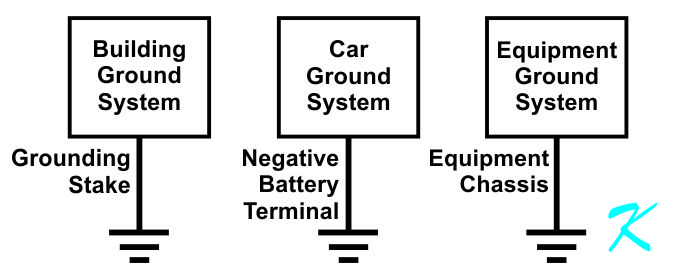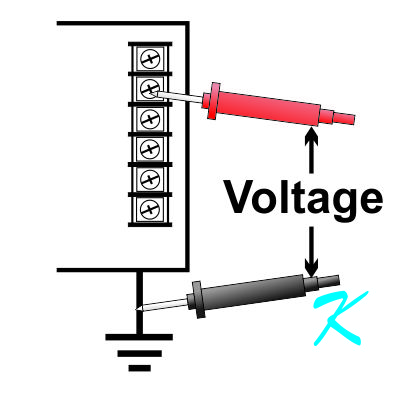Is Safety-Ground the Same as Signal-Ground?
By Douglas Krantz |
Electronics

An electrician drives a copper-clad stake into the earth and calls it ground. A car mechanic connects to the negative battery terminal of a car battery and calls it ground. An electronic technician repairing a printed circuit board connects to a specific point on the circuit board and calls it ground.
Are all of them correct?
What Is Ground?
In an electronic circuit, ground can be defined as "The Zero-Voltage Reference Point". All other voltages in the circuit are compared to this point. At least that's the theory.

When dealing with a building, ground is still the zero-voltage reference point. However, depending on who you ask, they talk about ground as the copper-clad stake driven into the earth, or the ground bar in a remote electrical breaker panel, or the ground pin on a grounded outlet, or the... you get the drift.
Point of View
Each person, when asked about ground in an electrical system, is referring to "Ground" from a different point of view. The answer might be referring to:
- The Copper Stake Driven into the Earth Ground
- Green Wire - Connected Directly to the Copper Stake Driven into the Earth
- Green Wire or Insulated Wire - Connected to the Nearest Electrical Panel Ground
- The Copper Grounding Plate on the Wall of the Data Room
- Conduit or Building Ground, in general
- Equipment Chassis Ground
- Equipment Circuit Board Ground
Each of these "Grounds" is different, and each of these "Grounds" affects signal transmission in different ways. When there's a problem, be aware that one ground in a building is not the same as another ground in the same building.
In a Building, Ground is What Someone Says It Is
Ground, as the words "Ground Connection" are used in a building, is defined by:
- Government Electrical Boards - like the State Board of Electricity. What they define, usually using the National Electrical Code (NEC) as much of their guideline, is a safety-ground. This is a definition of a ground designed to protect property and lives.
As a safety ground, there are exceptions to take into account, like fire alarm systems and signal transmission. These exceptions are addressed in the NEC and other publications by the National Fire Protection Association, Inc. (NFPA), as well as other governmental and private publications.
- Engineers and Technicians - like those who design equipment and whole systems, and those who maintain the equipment and whole systems. What they define as ground, using a whole library of electrical and electronic references, is actually a whole cluster of various "Grounds".
While still remaining within the constraints of safety-ground, engineers and technicians dealing with any kind of signal have to define "Ground" as being used:
- From one part to another of a single circuit board
- From one circuit board to another in the same piece of equipment
- From one piece of equipment to another in the same equipment rack
- From the equipment in one area of the building to another area of the building
- From a building to everywhere else in the world
Safety Ground versus Signal Ground
No equipment is perfect. Often times, equipment like heaters, air handlers, air conditioners, or appliances can, and do, leak a small electrical current onto the building ground system. Newer equipment usually has less leakage, but as equipment ages, small leakages do appear.
Safety-ground, remember, is used to drain the unwanted electrical current leakage. This happens to some extent in almost all buildings. Ohm's Law says that where there's current passing through resistance, voltage is present. All building grounding systems have at least a little resistance, so with the electrical current passing through, voltage can often be measured on building-ground from one area of a building to another.
When ground is only used for safety-ground, a volt or two on the ground system isn't going to be a fire danger or a shock hazard to anyone. However, trying to use low level signaling with that much differential voltage on ground makes sending signals more difficult.
Example: On the grounds for two outlets that were only 100 feet (30 m) apart, I've measured as much as 2-volts peak-to-peak. In that case, that much voltage difference on the safety-ground system destroyed the 1-volt video signal, and other arrangements had to be made.
Someone in charge of a building's electrical system would say that 2-volts peak-to-peak won't hurt anyone, while the electronic technician in charge of the television recording system considers the 2-volts peak-to-peak as making the remote camera totally unusable.
Example: In another instance, a 3-phase sub-panel was installed in a TV station building. The neutral wire was connected to the ground block in the main electrical switchgear panel, as required at that time by the NEC (the NFPA's National Electrical Code).
To do this, four large current carrying wires were installed in the conduit between the main switchgear panel and the sub-panel. The decision was made to not include a fifth heavy current carrying wire for a green wire ground in the conduit. Doing it that way saved money for the contractor.
In other words, the neutral wire was used as the ground wire. Current was always present on the neutral wire, which meant that nearly a volt was present in both the neutral and the ground inside the sub-panel, when compared to the ground for the rest of the TV station. Video and audio signals from there were unusable until "Hum-Buck Coils" were installed in the signal carrying wires.
In both cases, there was a legally installed Safety-ground, but not a usable signal-ground.
Ground Is as Ground Does
No ground is perfect. Even the earth around the copper clad stake called ground often has 20 ohms or more resistance. Usually, the building ground system has lower resistance, but small levels of voltage will always be present because small amounts of current will always be present.
At least legally, small voltages present on a building's safety-ground usually isn't a problem. However, when those small voltages present on ground are compared to the small voltages often used for signal transmission, the voltages on ground are often huge.
When designing circuits, or troubleshooting circuits, keep in mind that the voltage on one ground point in a building is not the same voltage as another ground point.

